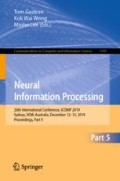Abstract
Interpreting the prediction mechanism of complex models is currently one of the most important tasks in the machine learning field, especially with layered neural networks, which have achieved high predictive performance with various practical data sets. To reveal the global structure of a trained neural network in an interpretable way, a series of clustering methods have been proposed, which decompose the units into clusters according to the similarity of their inference roles. The main problems in these studies were that (1) we have no prior knowledge about the optimal resolution for the decomposition, or the appropriate number of clusters, and (2) there was no method for acquiring knowledge about whether the outputs of each cluster have a positive or negative correlation with the input and output unit values. In this paper, to solve these problems, we propose a method for obtaining a hierarchical modular representation of a layered neural network. The application of a hierarchical clustering method to a trained network reveals a tree-structured relationship among hidden layer units, based on their feature vectors defined by their correlation with the input and output unit values.
Access this chapter
Tax calculation will be finalised at checkout
Purchases are for personal use only
References
Alain, G., Bengio, Y.: Understanding intermediate layers using linear classifier probes. In: ICLR 2017 Workshop (2017)
Ancona, M., Ceolini, E., Öztireli, A.C., Gross, M.: Towards better understanding of gradient-based attribution methods for deep neural networks. In: International Conference on Learning Representations (2018)
Bau, D., Zhou, B., Khosla, A., Oliva, A., Torralba, A.: Network dissection: quantifying interpretability of deep visual representations. In: Computer Vision and Pattern Recognition (2017)
Craven, M., Shavlik, J.W.: Extracting tree-structured representations of trained networks. In: Advances in Neural Information Processing Systems, vol. 8, pp. 24–30 (1996)
Doshi-Velez, F., Kim, B.: Towards a rigorous science of interpretable machine learning. arXiv:1702.08608 (2017)
Kingma, D.P., Ba, J.: Adam: a method for stochastic optimization. In: International Conference on Learning Representations (2015)
Krishnan, R., Sivakumar, G., Bhattacharya, P.: Extracting decision trees from trained neural networks. Pattern Recogn. 32(12), 1999–2009 (1999)
LeCun, Y., Bottou, L., Bengio, Y., Haffner, P.: Gradient-based learning applied to document recognition. Proc. IEEE. 86, 2278–2324 (1998)
Lipton, Z.C.: The mythos of model interpretability. In: Proceedings of the 2016 ICML Workshop on Human Interpretability in Machine Learning (2016)
Lundberg, S.M., Lee, S.: A unified approach to interpreting model predictions. In: Advances in Neural Information Processing Systems, vol. 30, pp. 4765–4774 (2017)
Luo, W., Li, Y., Urtasun, R., Zemel, R.: Understanding the effective receptive field in deep convolutional neural networks. In: Advances in Neural Information Processing Systems, vol. 29, pp. 4898–4906 (2016)
Nagamine, T., Mesgarani, N.: Understanding the representation and computation of multilayer perceptrons: a case study in speech recognition. In: Proceedings of the 34th International Conference on Machine Learning, pp. 2564–2573 (2017)
Raghu, M., Gilmer, J., Yosinski, J., Sohl-Dickstein, J.: SVCCA: singular vector canonical correlation analysis for deep learning dynamics and interpretability. In: Advances in Neural Information Processing Systems, vol. 30, pp. 6076–6085 (2017)
Ribeiro, M.T., Singh, S., Guestrin, C.: “Why should I trust you?”: explaining the predictions of any classifier. In: Proceedings of the 22nd ACM SIGKDD International Conference on Knowledge Discovery and Data Mining, pp. 1135–1144 (2016)
Shrikumar, A., Greenside, P., Kundaje, A.: Learning important features through propagating activation differences. In: Proceedings of the 34th International Conference on Machine Learning, pp. 3145–3153 (2017)
Simonyan, K., Vedaldi, A., Zisserman, A.: Deep inside convolutional networks: visualising image classification models and saliency maps. In: ICLR 2014 Workshop (2014)
Singh, C., Murdoch, W.J., Yu, B.: Hierarchical interpretations for neural network predictions. In: International Conference on Learning Representations (2019)
Springenberg, J.T., Dosovitskiy, A., Brox, T., Riedmiller, M.: Striving for simplicity: the all convolutional net. In: ICLR 2015 Workshop (2015)
Sundararajan, M., Taly, A., Yan, Q.: Axiomatic attribution for deep networks. In: Proceedings of the 34th International Conference on Machine Learning, pp. 3319–3328 (2017)
Thiagarajan, J.J., Kailkhura, B., Sattigeri, P., Ramamurthy, K.N.: Treeview: peeking into deep neural networks via feature-space partitioning. In: NIPS 2016 Workshop on Interpretable Machine Learning in Complex Systems (2016)
Wagner, J., Köhler, J.M., Gindele, T., Hetzel, L., Wiedemer, J.T., Behnke, S.: Interpretable and fine-grained visual explanations for convolutional neural networks. In: Computer Vision and Pattern Recognition (2019)
Ward, J.H.: Hierarchical grouping to optimize an objective function. J. Am. Stat. Assoc. 58(301), 236–244 (1963)
Watanabe, C., Hiramatsu, K., Kashino, K.: Modular representation of autoencoder networks. In: Proceedings of 2017 IEEE Symposium on Deep Learning, 2017 IEEE Symposium Series on Computational Intelligence (2017)
Watanabe, C., Hiramatsu, K., Kashino, K.: Recursive extraction of modular structure from layered neural networks using variational Bayes method. In: Yamamoto, A., Kida, T., Uno, T., Kuboyama, T. (eds.) DS 2017. LNCS (LNAI), vol. 10558, pp. 207–222. Springer, Cham (2017). https://doi.org/10.1007/978-3-319-67786-6_15
Watanabe, C., Hiramatsu, K., Kashino, K.: Knowledge discovery from layered neural networks based on non-negative task decomposition. arXiv:1805.07137v2 (2018)
Watanabe, C., Hiramatsu, K., Kashino, K.: Modular representation of layered neural networks. Neural Netw. 97, 62–73 (2018)
Watanabe, C., Hiramatsu, K., Kashino, K.: Understanding community structure in layered neural networks. arXiv:1804.04778 (2018)
Zahavy, T., Ben-Zrihem, N., Mannor, S.: Graying the black box: understanding DQNs. In: Proceedings of the 33rd International Conference on Machine Learning, pp. 1899–1908 (2016)
Author information
Authors and Affiliations
Corresponding author
Editor information
Editors and Affiliations
Rights and permissions
Copyright information
© 2019 Springer Nature Switzerland AG
About this paper
Cite this paper
Watanabe, C. (2019). Interpreting Layered Neural Networks via Hierarchical Modular Representation. In: Gedeon, T., Wong, K., Lee, M. (eds) Neural Information Processing. ICONIP 2019. Communications in Computer and Information Science, vol 1143. Springer, Cham. https://doi.org/10.1007/978-3-030-36802-9_40
Download citation
DOI: https://doi.org/10.1007/978-3-030-36802-9_40
Published:
Publisher Name: Springer, Cham
Print ISBN: 978-3-030-36801-2
Online ISBN: 978-3-030-36802-9
eBook Packages: Computer ScienceComputer Science (R0)

